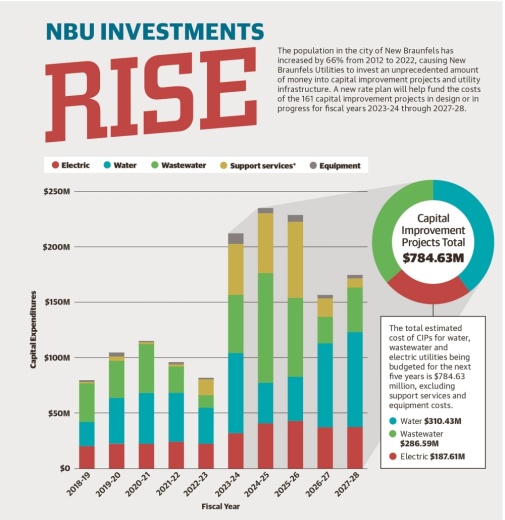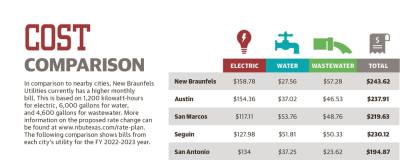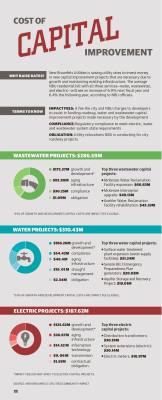The proposed rate adjustments will allow NBU to maintain prudent financial operations, appropriate debt coverage ratios and adequate reserve fund levels for electric operations while investing in capital improvement projects, according to NBU officials.
Over the last six years, the utility has been working to expedite its capital, according to NBU CEO Ian Taylor.
“Our capital plan has grown three times from what it normally was in order to keep up with growth,” Taylor said. “And as a result of that we were even having to throttle back development so that we will not approve engineering plans for new developments until our own projects are online.”
Building for growth
New Braunfels City Council approved the rate plan during a regular meeting April 10. That came after it received a presentation on how the rate plan contributes to the utility’s fiscal year 2023-24 budget and five-year financial operating plan during a workshop meeting April 3.
The two-year rate plan will be in effect from FY 2023-24 to FY 2024-25, according to NBU. Across all customer classes, electricity rates will increase by an average of 4.8% in FY 2023-24 and 5.9% in FY 2024-25.
Freese and Nichols, an engineering firm, completed a cost of service and rate design study over the past two years that analyzed whether rates were being properly allocated to each customer classification and made recommendations toward the approved two-year rate plan.
Based on results from the study, an average increase of sewer rate charges of 7.3% are proposed over the next two years. Water rates are proposed to increase by an average of 9.1% in FY 2023-24 and 13.4% in FY 2024-25.
The new electric, water and wastewater rates are driven primarily from the need to acquire a new water supply and build infrastructure to keep up with growth as well as meet regulatory requirements set by the Texas Commission on Environmental Equality, according to NBU officials.
The new rate plan will help fund 161 capital improvement projects totaling nearly $1 billion that are in design stages or in progress by the utility for the next five years.
Taylor cited Winter Storm Uri as an example of how failure in utility delivery can be disastrous.
“Each one of those three—water, sewer, electricity—when they’re not operating properly and when they’re not resilient, it truly is a risk to the public safety and to the public health,” Taylor said.
Taylor said the growth rate of the community is attributing to the need to build additional utility infrastructure throughout the city, including water and wastewater treatment plants as well as electricity discharge stations. Those additions lead to an increase in rates. Investment into maintaining existing infrastructure is also contributing to a higher expenditure by the utility.
“There was a significant construction •effort in New Braunfels, all the way up till the early ‘90s,” Taylor said. “And we as a community had the ability to ride out that capacity up until just recently.”
One of the alternative funding sources that will be used to contribute to these projects are impact fees, which are allowed by the local government code as a mechanism for new development to pay for its impact on water and wastewater systems.
New Braunfels City Council and the NBU board of trustees approved charging developers the maximum amount in impact fees allowable under state law, and that went into effect earlier this year. NBU officials anticipate receiving $169 million in impact fees over the next five years to help fund capital projects throughout the city.
According to NBU’s Chief Financial Officer Dawn Schriewer, growth was one of the most important assumptions that went into the utility’s five-year operating budget. The utility estimates growth across all lines of its business to be at 4.9% over the next five years.
“Those dollars [from impact fees] can be used to help offset projects that are related to growth,” Schriewer said. “And that helps our customers because then it doesn’t roll into the rates. So that development will be paying for a portion of the development.”
The current average residential utility bill for NBU customers is 10.42% more than surrounding communities, including San Antonio, San Marcos, Seguin and Austin.
According to Taylor, if City Council chose to vote against approving the two-year rate plan, NBU would begin burning through its reserves, prioritize capital projects and be at risk for paying fines for being out of compliance with the Texas Commission on Environmental Quality.
“We don’t want to ask for rate increases,” Taylor said. “We look for revenue from every other source prior to looking at rates.”
Community input
For the first time, a Rate Advisory Committee was formed in February 2021 to make recommendations to determine a cost of service based on customer class, accommodating growth, revenue sufficiency, utility stability and financial strength, among other considerations.
Committee Chair Justin Meadows gave a presentation during a April 3 City Council workshop on the recommendations the group made to the NBU board.
“The Rate Advisory Committee is recommending spreading out rate [changes] over a set period of time rather than exposing ratepayers to potentially significant swings in rates, whether up or down, year over year,” Meadows said.
The committee recommended NBU’s bill assistance program funding increase alongside the increase in utility rates to provide additional support to customers.
Some of the other recommendations to be implemented include focusing on conservation efforts and creating new customer classes for water users with the intention of lowering certain customers’ bills. Among those are large commercial water customers and those who use less than 3,000 gallons per month.
“As you consider the Rate Advisory Committee feedback and [what] NBU is proposing to you today, remember about 80% of it is about capital ... .” Meadows said. “Things have to get worse before they get better. But I’d rather things get worse than have sewage running down our streets.”
Mayor Rusty Brockman said things have not been easy for the utility company since Winter Storm Uri occurred in February 2021, but community input and the formation of the committee has led to improvements for NBU. Brockman said the future capital improvement projects, which take up 73% of the $1.41 billion five-year operating budget, are imperative to the city.
“There’s no way on God’s green earth that I want to continue to kick this can down the road for my kids and my grandkids, or your kids to have to deal with,” he said. “This is a big issue moving forward. We’ve got the opportunity as a community to work together and make it happen.”
New Braunfels resident Loree Schrank spoke at the April 3 workshop against the rate increases.
“For now, over three years, I and others have come before you and have asked you to put a moratorium on development until our infrastructure and stuff can all get caught up,” Schrank said. “We’ve been ignored. Now we’re going to pay the price for it.”
Looking forward
According to Taylor, NBU has 353 employees, but according to a workforce planning study, it needs to have 462 employees to be considered fully staffed. There are plans within the five-year operating budget to help fund additional staff.
"We have about a 30% deficit in full-time employees right now,” Taylor said. “And it’s a problem for delivering services at the level that folks expect of us.”
The utility is also planning to invest in new technology and continues to plan its new headquarters, which would move it out of the building in the Main Plaza downtown.
In the future, NBU is planning to focus on meeting service expectations of the community and increasing its proficiency with distributed energy resources, such as solar and electric vehicles.
“Power is very expensive during the hottest part of the day, right in the summer,” Taylor said. “If there are enough distributed energy resources in the community ... that lowers the whole cost for electricity for the entire community.”








